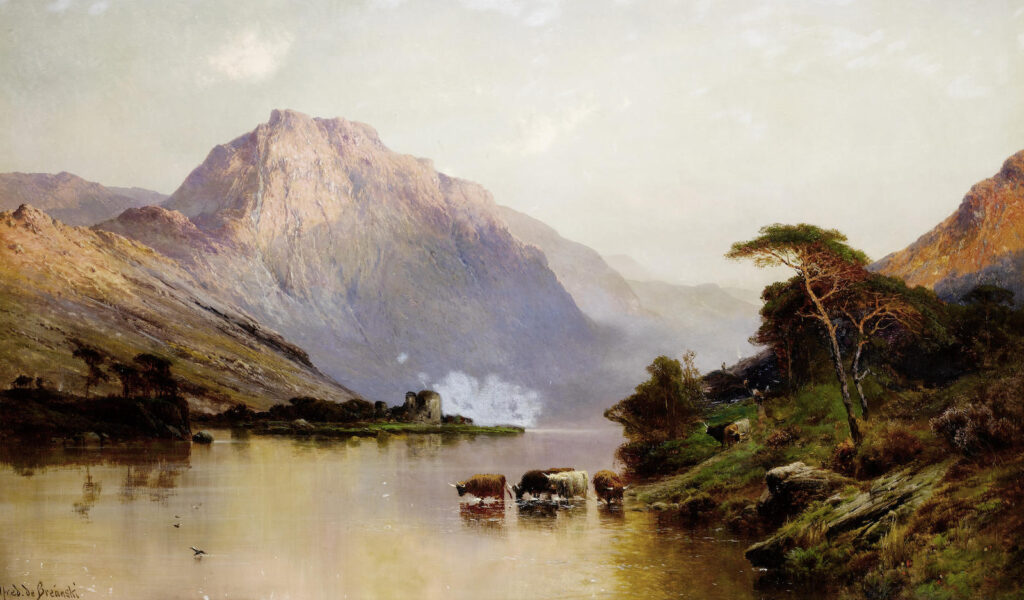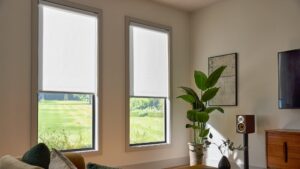High: Scottish Bens

The closer you get to the poles of the earth, the lower the altitude required for hills to become mountains. You can see this reflected in the treeline: in equatorial regions, trees grow on the summits of even high mountains; travel to the wilds of the far north, in the Nordic countries and Scotland, and you’ll see relatively low crags and bens poking their heads well clear of lowland forests. In Scotland, there’s another important factor for those who like to climb mountains: with the exception of areas like the Cairngorm Plateau in the east, every ascent starts from close to sea level.
The highest mountain in the British Isles, Ben Nevis, is in Scotland. Although only 1,345 metres (4,413 feet) in altitude, in winter conditions it’s as savage as any alp, and its north face presents sustained challenges to even the most experienced. Tragically, it’s also the site of several deaths each year, with not infrequent avalanches causing more in some winters.
Hugh William Williams (1773–1829), Glencoe (c 1812), oil on canvas, 61 × 91.5 cm, location not known. Wikimedia Commons.
Hugh William Williams was an early Scottish landscape specialist, who painted many popular topographic views of Scotland. He made this view of Glencoe in about 1812, before going to Europe. He captures the wildness of this glacial valley lined by some of the finest walking and climbing in Europe, including the peaks of Ben Nevis, the Three Sisters of Bidean nam Bian (1,150 metres, 3,770 feet), where four people were killed in an avalanche in 2013, and the Aonach Eagach ridge.
Alfred William Hunt (1830–1896), Glen Nevis, Scotland (c 1857), watercolour and scratching out on paper, 23.2 x 33.2 cm, The Crowther-Oblak Collection of Victorian Art, National University of Ireland, Galway. Courtesy of the Crowther-Oblak Collection of Victorian Art and and the National Gallery of Slovenia and the Moore Institute, National University of Ireland, Galway, via http://www.victorianweb.org/victorian/painting/hunt/paintings/7.html
Alfred William Hunt started his career as a classical scholar, poet, and writer, before he visited Scotland and painted this watercolour of Glen Nevis, Scotland from about 1857.
Sidney Richard Percy (1821–1886), On the Road to Loch Turret, Crieff (1868), oil on canvas, 61 × 96.5 cm, location not known. Wikimedia Commons.
Looking beyond the standardised staffage in the foreground of Sidney Richard Percy’s On the Road to Loch Turret, Crieff (1868), his mountains and clouds look wonderfully authentic. This location is near the market town of Crieff, on the busy road between Perth and Crianlarich, but Percy’s track is more remote, and still little-visited. It was probably used by Highland drovers to take their cattle to market in Crieff, then a major outlet for livestock from further north. The peak in the distance is most probably Ben Chonzie (931 metres, 3,054 feet), just high enough to qualify as a ‘Munro’, one of the 282 Scottish peaks over 3,000 feet.
Sidney Richard Percy (1821-1886), Carn Dearg and Ben Nevis from Achintee (1874), oil on canvas, 61 x 97 cm, location not known. Wikimedia Commons.
Percy’s Carn Dearg and Ben Nevis from Achintee from 1874 shows one of the finest views of the Ben Nevis massif. Càrn Mòr Dearg, as it’s more correctly known, is the mountain in front of Ben Nevis, and they’re connected by the spectacular ridge of the Càrn Mòr Dearg Arête, a challenging and exposed scramble even in good conditions.
Frank E Jamieson (1834-1899) (attr), Scottish Lake Landscape in Front of Mountains (date not known), oil on canvas, 51 x 76 cm, location not known. Wikimedia Commons.
This painting of a Scottish Lake Landscape in Front of Mountains is signed by Frank E Jamieson, but that could refer to the father of that name, or to his son, Francis E Jamieson, a prolific commercial artist who worked under many pseudonyms. It’s thought that this is a view of Loch Awe, here the hills at its north-east tip, viewed from Kilchurn Castle Island, with either Ben Cruachan or Ben Lui in the distance.
Gustave Doré (1832–1883), Scottish Highlands (1875), oil on canvas, 108.6 x 183.2 cm, Toledo Museum of Art, Toledo, OH. Wikimedia Commons.
Gustave Doré was one of at least two major French artists who visited the Highlands, in 1873 to fish for salmon, and fell in love with the country. One of his best paintings of the Highlands is Scottish Highlands (1875). This was painted in his studio from sketches and studies he had made during his tour, and its view hasn’t been located precisely as far as I’m aware.
Alfred de Bréanski (1852-1928), Inverlochy and Ben Nevis (date not known), oil on canvas, 76 × 127 cm, location not known. Wikimedia Commons.
Alfred de Bréanski’s Inverlochy and Ben Nevis is a view of the Ben Nevis massif from near Inverlochy Castle, to the north-east. Inverlochy grew into a substantial village in the 1920s as the result of the construction of an aluminium smelter there, powered by the abundant cheap electricity generated from local hydro-electric schemes. De Bréanski shows what I can only interpret as a large area of snow and ice remaining at the foot of Ben Nevis, which appears unusual, although there are other smaller patches further up its towering cliffs.
William Watson (1840-1921), Highland Wanderers – Morning Glen Croe, Argyllshire (1906), oil on canvas, 81 x 122 cm, location not known. Wikimedia Commons.
This final painting was made by a British animalière, William Watson. He was a member of the Watson family of artists, the one who specialised in landscapes featuring cattle and sheep. This example of his work, Highland Wanderers – Morning Glen Croe, Argyllshire from 1906, shows a valley in the middle of the Arrochar ‘Alps’, an exceptionally rugged mountainous area of the Cowal Peninsula, to the north-west of Loch Lomond. The notable peak here is perhaps Beinn Ìme (1,011 metres, 3,317 feet), the highest in the group, and another challenging Munro.



